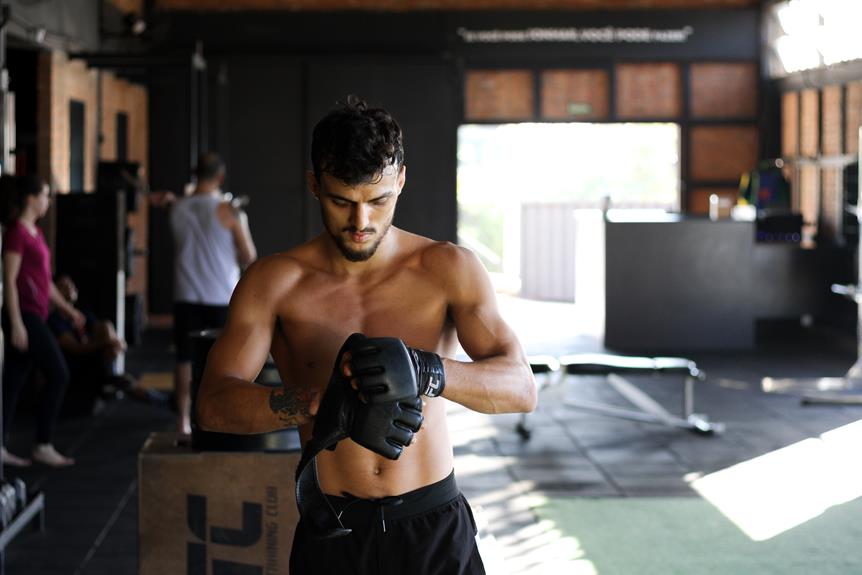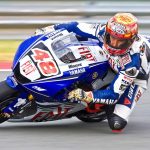In the world of mixed martial arts (MMA), where skill and physicality intertwine, the quest to find the best body type becomes a captivating pursuit.
Picture the arena, where fighters of all shapes and sizes converge, their bodies honed and sculpted for battle.
This article delves into the intricacies of body types in MMA, examining the unique attributes and advantages they offer.
With a focus on in-depth knowledge and an enthusiastic spirit, we explore the question: What is the ultimate body type for MMA?
Key Takeaways
- The best body type for MMA is the mesomorph body type, which is well-rounded and lacks specific weaknesses.
- Ectomorphs, characterized by their taller and thinner build, excel in striking but struggle in wrestling and grappling due to lower body strength.
- Mesomorphs, with their average to tall height and regular-length limbs, have no specific weaknesses and are well-rounded in all aspects of MMA.
- Endomorphs, who are generally shorter and have thicker limbs, are strongest in grappling but weakest in both Bjj and striking. They have lower cardiovascular endurance and tire earlier.
Overview of Body Types in MMA
The overview of body types in MMA provides insight into the strengths and weaknesses of each body type, aiding in the determination of the best body type for the sport. Understanding how body type impacts MMA performance is crucial for fighters to maximize their potential in the ring.
In MMA, there are three main body types: ectomorph, mesomorph, and endomorph. Each body type has its own advantages and disadvantages.
Ectomorphs, characterized by their tall and thin physique, excel in striking due to their height and reach advantage but struggle in wrestling and grappling.
Mesomorphs, with their well-rounded physique and balanced attributes, have no specific weaknesses and are considered the best body type for MMA.
Endomorphs, who tend to be shorter and stockier, are strongest in grappling but weakest in both BJJ and striking.
While body type plays a role, it is important to remember that success in MMA is not solely determined by body type, but also by training, technique, strategy, and mental toughness.
Ectomorph Body Type in MMA
Discussing the ectomorph body type in MMA involves examining the strengths and weaknesses of fighters with this physique.
Ectomorph fighters are generally taller with longer and thinner bones and muscles, giving them a height and reach advantage. However, their narrow body and lack of muscle mass can pose challenges in grappling and wrestling due to lower body strength and stability.
How does the ectomorph body type affect striking in MMA?
Their height and reach advantage allows them to utilize long-range strikes effectively, making them proficient in striking techniques.
Can ectomorph fighters overcome their weaknesses in grappling?
While ectomorphs may struggle in grappling due to their lower body strength, they can still improve their skills through dedicated training, technique, and strategy.
With the right approach, ectomorph fighters can overcome their weaknesses and excel in all aspects of MMA.
Mesomorph Body Type in MMA
When considering the mesomorph body type in MMA, it is important to understand its advantages and strengths in the sport.
Mesomorph fighters are well-rounded in all aspects of MMA, with no specific weakness. They have the perfect balance between strength, cardiovascular endurance, explosiveness, reach, and height.
Compared to ectomorphs, mesomorphs have more power and explosiveness in strikes and movement. They excel in wrestling, both standing and on the ground, and have the ideal physique for controlling opponents.
In contrast to endomorphs, mesomorphs have a wider shoulder-to-waist ratio, which gives them better stability and agility.
Endomorph Body Type in MMA
The advantages and weaknesses of the endomorph body type in MMA can be examined through an analysis of its characteristics:
- Endomorph body type disadvantages:
- Endomorphs tend to have a higher body fat percentage, which can negatively impact their cardiovascular endurance and stamina.
- Due to their shorter limbs and height, endomorphs may struggle with reach disadvantage against opponents with longer limbs.
- Endomorphs may find it more challenging to maintain a lower body weight, which can affect their agility and speed in the cage.
- Endomorph body type advantages:
- Endomorphs typically have a naturally higher level of strength and power, making them formidable in grappling situations.
- Their thicker and shorter limbs can provide them with a compact and solid base, enhancing their ability to control opponents on the ground.
- Endomorphs are known for their knockout power in striking, allowing them to deliver devastating blows that can end a fight quickly.
While the endomorph body type in MMA has its disadvantages, fighters with this body type can capitalize on their strengths in grappling and striking power. By understanding their limitations and working on their weaknesses, endomorphs can develop a well-rounded skill set that maximizes their potential in the cage.
The Bottom Line
In conclusion, the mesomorph body type is widely considered the optimal choice for MMA due to its well-roundedness and absence of specific weaknesses. While the ectomorph body type may excel in striking due to their height and reach advantage, they struggle in wrestling and grappling due to lower body strength and stability.
On the other hand, the endomorph body type may have knockout power in striking and strength in grappling, but they have lower cardiovascular endurance and are at a disadvantage in terms of reach and height. The mesomorph body type, with its average to tall height, regular-length limbs, and wider shoulder-to-waist ratio, is well-balanced in all aspects of MMA.
They have more power and explosiveness in strikes and movement, excel in wrestling, and possess the perfect balance for controlling opponents. However, it is important to note that while body type plays a role in MMA, it is not the sole determinant of success.
Training, technique, strategy, and mental toughness are equally crucial in achieving MMA success. Ultimately, the best body type for MMA is the one that suits an individual fighter's style, strengths, and weaknesses.
Factors Influencing MMA Success
Factors influencing MMA success include a combination of training, technique, strategy, and mental toughness. These factors are crucial for fighters to excel in the sport and achieve their goals.
Here are the key factors that contribute to MMA success:
- Importance of training:
- Training plays a vital role in developing the physical attributes required for MMA, such as strength, endurance, speed, and flexibility.
- Consistent and structured training programs help fighters refine their skills and improve their overall performance.
- Specialized training in various disciplines, including striking, grappling, wrestling, and conditioning, is essential for a well-rounded MMA fighter.
- Importance of technique:
- Mastering proper technique is fundamental in MMA, as it allows fighters to optimize their movements and maximize their effectiveness.
- Techniques such as striking combinations, takedowns, submissions, and defensive maneuvers need to be honed through dedicated practice and repetition.
- Understanding and implementing effective strategies during fights is greatly influenced by the mastery of technique.
- Importance of mental toughness:
- MMA is a physically demanding and mentally challenging sport, and mental toughness is crucial for success.
- Fighters need to develop mental resilience, focus, and determination to overcome adversity, handle pressure, and make quick decisions during fights.
- Mental training techniques, such as visualization, meditation, and positive self-talk, can help enhance mental toughness and improve performance in the cage.
Frequently Asked Questions
Are There Any Advantages to Having an Ectomorph Body Type in Mma?
The advantages of an ectomorph body type in MMA include a height and reach advantage in striking, as well as a higher metabolism for increased calorie burn. However, weaknesses in lower body strength and stability may hinder grappling and wrestling.
Can an Endomorph Fighter Be Successful in MMA Despite Their Weaknesses in Striking and Bjj?
Despite the weaknesses in striking and BJJ, an endomorph fighter can still be successful in MMA. However, the mesomorph body type is generally considered the best for MMA due to its well-roundedness and lack of specific weaknesses, particularly in grappling skills.
How Much Does Body Type Impact an MMA Fighter's Success Compared to Other Factors Like Training and Technique?
The impact of body type on MMA performance is significant but not overriding. While body type influences advantages and disadvantages, factors like training, technique, strategy, and mental toughness are equally crucial in determining success in MMA.
Are There Any Famous MMA Fighters Who Have an Ectomorph Body Type?
Ectomorph fighters in MMA, such as Jon Jones and Conor McGregor, have advantages in striking due to their height and reach advantage. However, the impact of body type on MMA success is not as significant as factors like experience, strategy, and training.
Can a Fighter Change Their Body Type Through Training and Nutrition to Better Suit Their Style in Mma?
While body type plays a role in MMA, fighters can optimize their performance through training and nutrition. Understanding their strengths and weaknesses, they can strategically develop their body to better suit their style in MMA.
Conclusion
In conclusion, understanding the different body types prevalent in MMA is essential for aspiring fighters and coaches.
While the mesomorph body type is often considered the most advantageous due to its balanced attributes, it is important to note that success in MMA is not solely determined by body type.
Factors such as training, technique, strategy, and mental fortitude all contribute to a fighter's success in this demanding sport.
Ultimately, finding the right body type for MMA is subjective and dependent on individual preferences and fighting styles.
As the saying goes, 'Different strokes for different folks.'
- 15 Best Martial Arts Weapons (Fighting & Training) - October 14, 2024
- Is Fencing a Martial Art? (Yes, 4 Reasons Why) - October 14, 2024
- 7 Best Martial Arts for Self-defense Ranked (Highly Effective) - October 14, 2024










